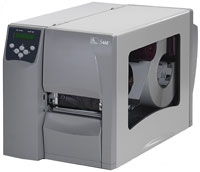Aerospace Parts Supplier Flies Through Order Processing and Shipments with Bar Codes

Challenge:
This 25 year-old Florida-based specialty metals supplier needed a better way to respond to requests for urgent shipments from airline customers without compromising accuracy.
Solution:
The company implemented a bar code labeling system to mark shipments appropriately for their customers’ receipt. “We used to hand-write all the destination information on the materials, which was very time consuming,” says the MIS director. “Now, with bar coding, we quickly print labels as needed and are able to locate all shipments at all times. This is a necessity when we have an AOG status (airplane on the ground), which needs parts immediately.”
Products:
Zebra® S Series™ industrial printer and specialty labels. An industrial printer from Zebra generates labels from eight computer terminals linked to UNIX-based PICK software on the company’s Data General mainframe. Sales people within the office take the orders and assign an order number within the system. Operators within the warehouse pull up the orders on the terminals and decide what materials need to be picked from inventory and how they should be bundled. Long tables, with Interleaved 2 of 5 bar codes marked at every inch, allow the workers to measure the aerospace-grade metal and tally the amount needed for the order.
Before bar coding, an average order took two people with a calculator and tape measure 20 minutes to complete. With bar codes along the length of the table, the material is laid out and measured in a matter of minutes. More orders, including materials for landing gear and tubing for jet engines, are processed in less time. This process is critical to the company’s operations. All the material is measured and bundled according to heat and lot, which is important for tracking purposes by the Federal Aviation Administration.
Once the order has been appropriately cut and bundled, items are packaged within wooden boxes with a bar coded shipping label applied to the box. Operators can print labels on demand, whether it’s one, two, or ten, depending on the shipment size. The company took care to select label materials to match the rigors of the industry. Because they ship internationally, parcels could be sitting on docks for various lengths of time, subjected to sunlight, rain, and abrasion. “The labels definitely need to withstand many different elements,” says the project leader. “Also, since the labels can be affixed to the wooden shipping crates, cardboard tubes, or directly on the metal, a specific label adhesive was chosen to ensure the labels remain affixed to all types of traveling packages.”
Results:
Because of the traceability requirements of aerospace material, the company now uses bar codes for greater control and in turn has made significant productivity gains. With bar coding in place throughout the organization, the company can continue with regular, yearly contract shipments, while quickly and successfully responding to a number of urgent shipments on a daily basis.




